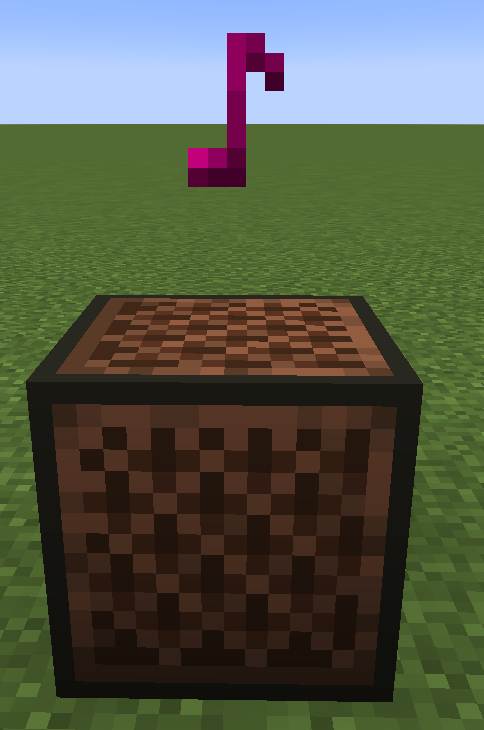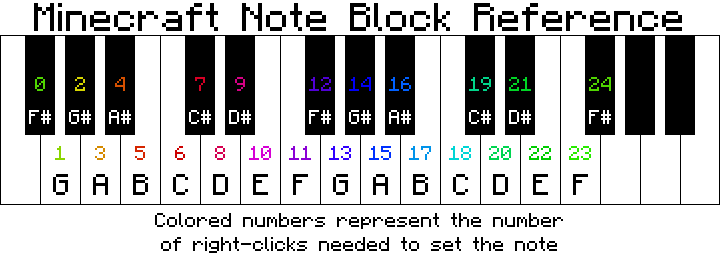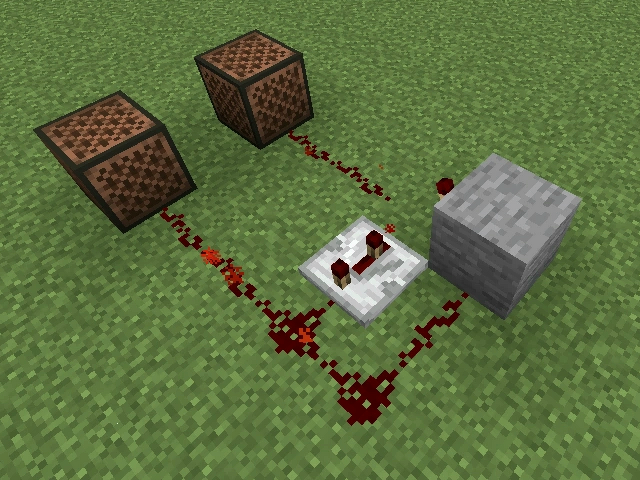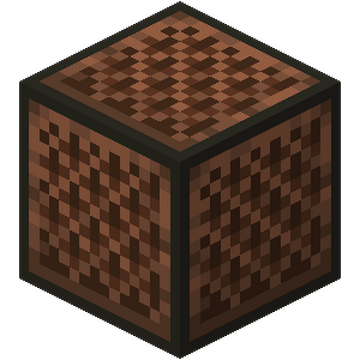A note block is a block that emits sounds when attacked, used or powered with redstone. The sound produced can be altered in various ways by using it or putting certain blocks directly above or below it. A note block's sound played repeatedly can be used to direct allays to stay nearby and drop collected items near it.
Obtaining
Natural generation
Note blocks generate in ancient cities.
Breaking
Note blocks are most quickly broken with an axe.
| Block | Note Block | |
|---|---|---|
| Hardness | 0.8 | |
| Tool | ||
| Breaking time[A] | ||
| Default | 1.2 | |
| Wooden | 0.6 | |
| Stone | 0.3 | |
| Iron | 0.2 | |
| Diamond | 0.15 | |
| Netherite | 0.15 | |
| Golden | 0.1 | |
- ↑ Times are for unenchanted tools as wielded by players with no status effects, measured in seconds. For more information, see Breaking § Speed.
Crafting
| Ingredients | Crafting recipe |
|---|---|
| Any Planks + Redstone Dust |
Usage
Playing music
Notes

Note blocks play a musical note when hit (pressing the attack button) or powered by redstone. A note block must have air in the space directly above it to play a sound. Notes can be heard up to 48 blocks away. The volume of a note block decreases as the player gets further away from it. The volume of note blocks (as well as jukeboxes) can be independently controlled by the Jukebox/Note Blocks slider in the audio settings.
Note blocks play when on or next to a powered block. Each time a note block plays a note, a note particle may fly out of the top (if pressed too fast, notes may not appear), with the color depending on the pitch (but not the instrument).
There are 16 different instruments and 25 different pitches per instrument. Pressing the use button on the block increases the note pitch up a semitone, with a total of two full octaves and a semitone (25 semitones in total) being available for each instrument. The standard range (for harp and pling instruments) of notes span from F♯3 to F♯5. After reaching the highest note, pressing use again resets the pitch back to F♯3, as does breaking the block and picking it back up.
The string bass and didgeridoo are two octaves (24 semitones) lower than the standard range, the guitar is one octave (12 semitones) lower than the standard range, the flute is one octave above the standard range, and the bells, chimes, and xylophone are 2 octaves above the standard range. This gives the player six octaves (72 semitones) of effective range to combine instruments for greater pitch coverage.
The exact pitch can be found from its use-count by using the following formula: 2 ^ ((use count - 12) / 12).
The exact pitch to use-count assignment is shown below,[1][2] along with the note's color, which is rendered with shading using the particle's texture.
|
|
Alternatively, there is a graphical version available:

Players can roughly check the tuning of a block by looking at the note icon.

In Java Edition, the tuning can also be checked by looking at the right side of the debug screen (accessed by pressing F3). It is denoted as "note:" followed by a number from 0 to 24.
Instruments
The instrument played depends on the material of the block underneath the note block. Note that these are groups of blocks defined by the code, not just the individual block.
Mob heads
When a mob head is placed on top of a note block, the sound made by the note block will instead be that of the corresponding mob's ambient sound, with the exception of the creeper head, which instead causes the note block to play the primed sound.
| Block | Instrument | Range | Sound event names (Java) | Sound event names (Bedrock) |
|---|---|---|---|---|
| Material: Wood | Bass (String Bass) | F♯1–F♯3 | block.note_block.bass
|
note.bass
|
| Material: Sand, Gravel, Concrete Powder | Snare Drum | — | block.note_block.snare
|
note.snare
|
| Material: Glass, Sea Lantern, Beacon | Clicks and Sticks (Hihat) | — | block.note_block.hat
|
note.hat
|
| Material: Stone, Blackstone, Netherrack, Nylium, Obsidian, Quartz, Sandstone, Ores, Bricks, Corals, Respawn Anchor, Bedrock, Concrete, Observer | Bass Drum (Kick) | — | block.note_block.basedrum
|
note.bd
|
| Block of Gold | Bells (Glockenspiel) | F♯5–F♯7 | block.note_block.bell
|
note.bell
|
| Clay, Honeycomb Block[Bedrock Edition only] [3], Infested Block[Bedrock Edition only] | Flute | F♯4–F♯6 | block.note_block.flute
|
note.flute
|
| Packed Ice | Chimes | F♯5–F♯7 | block.note_block.chime
|
note.chime
|
| Wool | Guitar | F♯2–F♯4 | block.note_block.guitar
|
note.guitar
|
| Bone Block | Xylophone | F♯5–F♯7 | block.note_block.xylophone
|
note.xylophone
|
| Block of Iron | Iron Xylophone (Vibraphone) | F♯3–F♯5 | block.note_block.iron_xylophone
|
note.iron_xylophone
|
| Soul Sand | Cow Bell | F♯4–F♯6 | block.note_block.cow_bell
|
note.cow_bell
|
| Pumpkin | Didgeridoo | F♯1–F♯3 | block.note_block.didgeridoo
|
note.didgeridoo
|
| Block of Emerald | "Bit" (Square wave) | F♯3–F♯5 | block.note_block.bit
|
note.bit
|
| Hay Bale | Banjo | F♯3–F♯5 | block.note_block.banjo
|
note.banjo
|
| Glowstone | "Pling" (Electric piano) | F♯3–F♯5 | block.note_block.pling
|
note.pling
|
| Skeleton Skull | "Skeleton" | - | block.note_block.imitate.skeleton
|
note.skeleton
|
| Wither Skeleton Skull | "Wither Skeleton" | - | block.note_block.imitate.wither_skeleton
|
note.witherskeleton
|
| Player Head | Sound event set in note_block_sound | - | Dependent | Dependent |
| Zombie Head | "Zombie" | - | block.note_block.imitate.zombie
|
note.zombie
|
| Creeper Head | "Creeper" | - | block.note_block.imitate.creeper
|
note.creeper
|
| Piglin Head | "Piglin" | - | block.note_block.imitate.piglin
|
note.piglin
|
| Dragon Head | "Ender Dragon" | - | block.note_block.imitate.ender_dragon
|
note.enderdragon
|
| Any other blocks | Harp / piano | F♯3–F♯5 | block.note_block.harp
|
note.harp
|
Powering note blocks

Note blocks can be powered in a variety of different ways following normal redstone principles; however, some ways of powering note blocks are more convenient than others or produce unexpected results.
- When a note block is powered by a button on its side, it does play a note, but is often difficult to hear because the sound of the button can overlap the note block.
- Because note blocks need space above them, note blocks powered by pressure plates or redstone directly above them do not make a sound.
Interaction with allays
If an allay hears a note block play within 16 blocks of its location, it tries to path find to the note block and then spends 30 seconds around that particular note block, seeking items around it and returning them to it instead of its player. After 30 seconds, the allay returns to _targeting its player. A vibration particle emanates from the note block and reaches the allay to indicate the allay has locked on to the note block. Because the allay and the note block interact via a vibration particle, placing wool between the note block and the allay can prevent this interaction.
Fuel
Note blocks can be used as a fuel in furnaces, smelting 1.5 items per block.
Sounds
| Sound | Subtitles | Source | Description | Resource location | Translation key | Volume | Pitch | Attenuation distance |
|---|---|---|---|---|---|---|---|---|
| Block broken | Blocks | Once the block has broken | block | subtitles | 1.0 | 0.8 | 16 | |
| Block placed | Blocks | When the block is placed | block | subtitles | 1.0 | 0.8 | 16 | |
| Block breaking | Blocks | While the block is in the process of being broken | block | subtitles | 0.25 | 0.5 | 16 | |
| None[sound 1] | Entity-Dependent | Falling on the block with fall damage | block | None[sound 1] | 0.5 | 0.75 | 16 | |
| Footsteps | Entity-Dependent | Walking on the block | block | subtitles | 0.15 | 1.0 | 16 |
| Sound | Source | Description | Resource location | Volume | Pitch |
|---|---|---|---|---|---|
| Blocks | Once the block has broken | dig | 1.0 | 0.8-1.0 | |
| Blocks | When the block is placed | dig | 1.0 | 0.8 | |
| Blocks | While the block is in the process of being broken | hit | 0.23 | 0.5 | |
| Players | Falling on the block with fall damage | fall | 0.4 | 1.0 | |
| Players | Walking on the block | step | 0.3 | 1.0 | |
| Players | Jumping from the block | jump | 0.12 | 1.0 | |
| Players | Falling on the block without fall damage | land | 0.18 | 1.0 |
Data values
ID
| Name | Identifier | Form | Translation key |
|---|---|---|---|
| Note Block | note_block | Block & Item | block.minecraft.note_block |
| Name | Identifier | Numeric ID | Form | Item ID[i 1] | Translation key |
|---|---|---|---|---|---|
| Note Block | noteblock | 25 | Block & Giveable Item[i 2] | Identical[i 3] | tile.noteblock.name |
| Name | Savegame ID |
|---|---|
| Block entity | Music |
Block states
| Name | Default value | Allowed values | Description |
|---|---|---|---|
| instrument | harp | banjobasedrumbassbellbitchimecow_bellcreepercustom_headdidgeridoodragonfluteguitarharphatiron_xylophonepiglinplingskeletonsnarewither_skeletonxylophonezombie | The instrument of the note block. |
| note | 0 | 0123456789101112131415161718192021222324 | The pitch of the note block |
| powered | false | falsetrue | True if the note block is currently activated. |
Block data
In Bedrock Edition, a note block has a block entity associated with it that holds additional data about the block.
See Bedrock Edition level format/Block entity format.
Achievements
| Icon | Achievement | In-game description | Actual requirements (if different) | Gamerscore earned | Trophy type (PS4) | |
|---|---|---|---|---|---|---|
| PS4 | Other | |||||
| Birthday song | Have an Allay drop a cake at a noteblock | Tame an allay by giving it a cake while having dropped cake items and play a noteblock nearby. | 10G | Bronze | ||
Advancements
| Icon | Advancement | In-game description | Parent | Actual requirements (if different) | Resource location |
|---|---|---|---|---|---|
 | Birthday Song | Have an Allay drop a Cake at a Note Block | You've Got a Friend in Me | Give an allay a cake and then use a note block to make the allay drop the cake at a note block. This is a hidden advancement, meaning that it can be viewed by the player only after completing it, regardless of if its child advancement(s), if any, have been completed. | husbandry/allay_deliver_cake_to_note_block
|
History
| Java Edition Beta | |||||
|---|---|---|---|---|---|
| 1.2 | | ||||
| Note blocks have 5 instruments: Harp, Bass, Bass drum, Snare drum, Click. Pling is also added in the sound files, but is currently unused. | |||||
| Java Edition | |||||
| 1.0.0 | Beta 1.9 Prerelease 6 | Note blocks are now broken faster using an axe. | |||
| 1.2.4 | release | Spruce planks, birch planks, and jungle planks can now be used to craft note blocks. | |||
| 1.7.2 | 1.7.1 | Acacia planks and dark oak planks can now be used to craft note blocks. | |||
| 1.12 | 17w16a | Added sound events (but not the sounds themselves) for additional instruments (bell, chime, flute, guitar, xylophone) to note blocks. | |||
| 17w17a | Added sounds for additional instruments to note blocks. | ||||
| 1.13 | 17w47a | Note blocks can now be pushed by pistons. | |||
| 1.14 | 18w43a | | |||
| 19w09a | Added sounds to note blocks for additional instruments (iron xylophone, cow bell, didgeridoo, bit, banjo), and implemented the "Pling" instrument into the game. | ||||
| 1.16 | 20w06a | Crimson planks and warped planks can now be used to craft note blocks. | |||
| 1.19 | 22w11a | Mangrove planks can now be used to craft note blocks. | |||
| 22w13a | Note blocks now generate as part of ancient cities. | ||||
| Note blocks can now only be silenced with wool or wool carpets on top. | |||||
| 22w15a | The change to note block silencing mentioned above for 22w13a has now been reverted. | ||||
| 1.20 (Experimental) | 22w42a | Heads can now be placed on note blocks to play the respective mob sound. | |||
| 23w03a | Heads can now be placed on note blocks without sneaking. | ||||
| Pocket Edition Alpha | |||||
| v0.13.0 | build 1 | | |||
| v0.15.0 | build 1 | Note blocks can now be moved by pistons. | |||
| Bedrock Edition | |||||
| 1.10.0 | beta 1.10.0.3 | | |||
| 1.13.0 | beta 1.13.0.9 | Added all new note block sounds from Java Edition 1.12 and 1.14. | |||
| Wild Update (experimental) | beta 1.18.30.22 | A note block played near an allay becomes its favorite note block for 30 seconds. | |||
| Placing a block on top of a note block no longer mutes it, with the exception of wool blocks. | |||||
| 1.19.0 | beta 1.19.0.26 | The previous change has been reverted. | |||
| Next Major Update (Experimental) | beta 1.19.60.20 | Heads can now be placed on note blocks to play the respective mob sound. | |||
| 1.20.10 | beta 1.20.10.20 | Note blocks with soul soil underneath now produces the "harp" sound instead of "snare". | |||
| Legacy Console Edition | |||||
| TU1 | CU1 | 1.0 | Patch 1 | 1.0.1 | |
| TU53 | CU43 | 1.49 | Patch 23 | 1.0.3 | Added new note block sounds. |
| 1.90 | | ||||
| New Nintendo 3DS Edition | |||||
| 0.1.0 | | ||||
Data history
| Java Edition | |||||
|---|---|---|---|---|---|
| 1.9 | 15w34a | The power state of note blocks is now controlled through the powered tag, and therefore can now be controlled independently of any redstone signal. | |||
| 1.11 | 16w32a | The block entity ID of note blocks has been changed from Music to noteblock. | |||
| 1.13 | 17w47a | The ID has been changed from noteblock to note_block.
| |||
Note blocks are no longer block entities and instead are defined by the note, powered, and instrument block states. | |||||
| Prior to The Flattening, this block's numeral ID was 25. | |||||
Issues
Issues relating to "Note block" or "Noteblock" are maintained on the bug tracker. Report issues there.
Trivia
- Because a note block is a wooden type block, a note block directly on top of another one produces a string bass sound when powered.
- In Java Edition, note blocks have the second highest number of possible block state combinations, at 1150[verify], beating fire's 512 and behind redstone dust's 1296.
- In Creative mode, the only way to hit a note block to play it without breaking it or changing its pitch is by doing so while holding a sword.
Gallery
Pixel Artwork
See also
- Tutorials/Redstone music
- Tutorials/Redstone music/Doorbell
- Jukebox
- Minecraft Note Block Studio – A music editor for Minecraft.
References
External links
- Block of the Week: Note Block – Minecraft.net on June 1, 2018
- Search YouTube for the many songs played on note blocks





